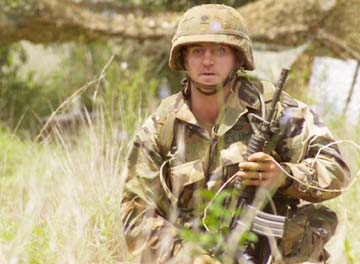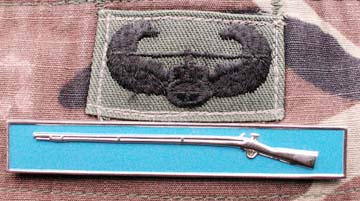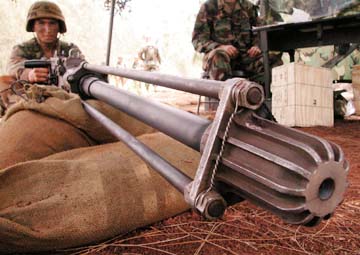


CRAIG T. KOJIMA / CKOJIMA@STARBULLETIN.COM
Spec. Ryan Flynn went through an obstacle course, part of a series of training events to prepare soldiers for combat.
Army Spec. John Williams was all smiles as he successfully passed his 24th infantryman's test at Schofield Barracks' East Range last week. Quest for the badge
Troops take on grueling tasks
to earn the coveted expert
infantryman's badgeSee also: In The Military
For Your Benefit
By Gregg K. Kakesako
gkakesako@starbulletin.comWith only 11 more tests to go, Williams, 20, was confident that he would be sporting the coveted silver and enamel expert infantryman's badge on his uniform that signified that he was among the best.
"The training I got has been the best," said Williams, who has been in the Army for the past 1 1/2 years.
Command Sgt. Maj. Drew Pumarejo, who set up last week's expert infantryman's test for the 2nd Battalion, 5th Infantry, said this is one of two major training events for 25th Division soldiers. "The other are the tests conducted at the combat-training center held at the Joint Readiness Training Center and our brigade will be going there at the end of January."

CRAIG T. KOJIMA / CKOJIMA@STARBULLETIN.COM
Soldiers of the 2nd Battalion, 5th Infantry took on different tasks last week at Schofield Barracks as they tried to earn the silver and enamel expert infantryman's badge, shown.
"The importance of these two training events is the variety of tasks soldiers need to know to succeed in combat," said Pumarejo, a veteran of the Panama and Grenada campaigns. "There is nothing like this other than the Joint Readiness Training Center that can simulate actual combat conditions."
While the Joint Readiness Training Center at Fort Polk in Louisiana tests how units like Pumarejo's 3rd Brigade will perform as a unit, the expert infantryman's evaluation measures a soldier as an individual. The 3rd Brigade is slated to travel to Fort Polk in January to test its readiness.
Soldiers in infantry units are tested on their marksmanship skills; ability to set up and fire six different types of weapons; navigation using a compass; physical fitness; and communication, nuclear, chemical, biological and medical knowledge.
"None of these tasks are new," said Pumarejo, a 21-year Army veteran. "This is what is taught in basic training."
At the end the soldiers must complete a 12-mile march carrying a 35-pound pack in three hours. "That comes out to a 15-minute mile and means they really have to step it up," said Pumarejo.
During the testing process, an expert instructor will closely observe the candidate's every move for the slightest deviation from the manual, timing each movement to the second with a stopwatch. Each candidate is allowed a single retest on one task.
Two hundred sixty soldiers belonging to the 2nd Battalion, 5th Infantry, were in line Wednesday when the tests began following two weeks of preparation.
By Friday night, 181 remained.
After completing a 12-mile march the soldiers were treated to a steak-and-eggs breakfast at their barracks before forming up to receive awards.
Pinning on the expert infantryman's badges on the 152 soldiers who survived the final test, the 12-mile road march, were 15 members of 5th Regimental Combat Team, which carried the unit's colors during the Korean War.
Of the 152 finalists, 58 were "true blues," soldiers who passed all 35 stations on the first try.

CRAIG T. KOJIMA / CKOJIMA@STARBULLETIN.COM
Soldiers in infantry units are tested on skills such as marksmanship; their ability to set up and fire six different types of weapons, like this .50-caliber machine gun; navigation; physical fitness and communication.
The Korean War veterans, led by retired Brig. Gen. Irwin Cockett and Mitsui Imai, president of the 5th Regimental Combat Team Korean War Veterans-Hawaii, also presented Lt. Col. Thomas Barth, commander of the 2nd Battalion, a $1,000 check to kick off a fund-raising drive.
Pumarejo said the 5th Regiment wants to raise $10,000 to commission Army artist Rick Reeves to paint a scene from its long and colorful history. "We're the third oldest regiment in the Army," said Pumarejo, tracing the unit's lineage to the 1808 Indian Wars.
The oil painting will hang in its conference room and will depict Gen. Matthew Ridgeway, U.S Forces commander in the Korean War, as he accompanied the 2nd Battalion and its fight against the Chinese in October 1951 in North Korea. Another 300 copies will be made and sold.
On Thursday, before the soldiers began the final testing phase, Pumarejo told them about a Chechen rebel commander killed that week who wrote in his diary the difference between U.S. and Russian soldiers. According to a news report cited by Pumarejo, the rebel leader wrote "when a Russian leader is killed, the unit stops and mills about, not sure of what to do next."
The Chechen commander, who also had fought the Americans, noted, however, that when they "took out a U.S. leader, somebody always quickly takes his place with no loss of momentum."
"That's why we are here," Pumarejo told his soldiers. "That's why we are doing this EIB training. That's why we're the greatest army in the world."